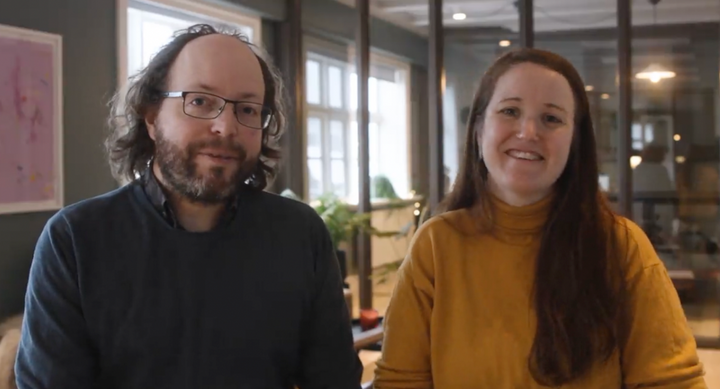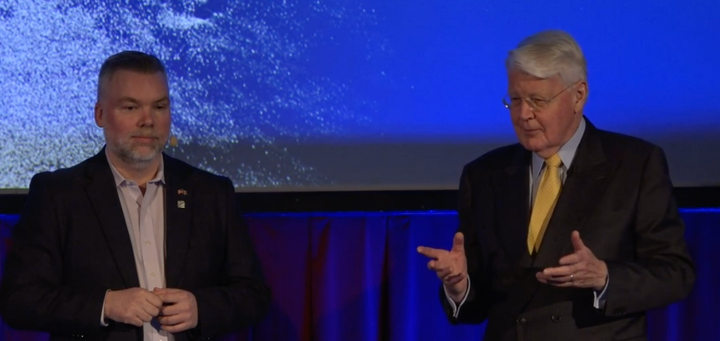The Data-Nerd Approach to Seed Funding

Today, we’re cross-posting an insightful article by Stefán Baxter, the CEO of Quick Lookup, that was originally posted on their Medium blog.
In the article, Stefán highlights his very thorough data driven approach to their next fundraising effort. If you’re a founder, VC or interested in the fundraising process, pull up a chair and read on.
Intro
As a founder, I love the team, the product, and the journey. However, I’ve never loved the fundraising part, even though it is essential to the journey and can neither be neglected nor played down.

Don’t get me wrong, I’ve only completed seed funding once, and that case was an outlier. At Activity Stream, we met four funds and closed three. Now, depending on your view, that is either extremely lucky or terribly lazy.
For Quick Lookup, a data sourcing solution for business-related information, I’m approaching the seed funding as a relationship-building, data-driven sales and process optimization effort rather than an “asking for money” or a “pure fundraising” effort.
I do this because I love data, I enjoy sales, and I’m obsessed with process optimization and also because I will need all the drivers and all the motivation to get through this 🙂
This post highlights the preparation process and includes a video at the end, showing some of the steps in detail for those interested.
Primary Objectives
Most will agree that the main objective of fundraising is de-risking operations and advancing and/or accelerating a journey. We certainly do, and here are some of our additional objectives.
- We aimed to build a prioritized list of funds and investors to approach for our seed round. The list could include funds we are too early for if we want to reach out and initiate a get-to-know-each-other relationship.
- We aim to save time, both ours and investors and have a clear and meaningful answer to the question “Why are you approaching us?” for everyone we reach out to.
- We aim to find investors that appreciate our journey and the complex problem we are solving and share our vision for Quick Lookup’s role in the future.
A Small Set of Tools
We decided to use simple, readily available tools to prepare our seed round and to share our approach with others. This post starts to explain what we did and how we did it. We hope it is helpful.

Airtable has become my favourite tool when working with linked and loosely defined data in tiny volumes. LinkedIn and Crunchbase should need no introduction. Later we will share how we also used Zapier for process automation and Neo4j for in-depth network mapping.
A Raw List of Funds and Investors
Initially, we built a list that was a compilation of what we knew and could quickly discover with Google searches for “lists of x, y or z” and by using a few free tools that offer VC directories and match-making services. The results were OK, but we felt something was still missing.
This feeling was confirmed when we got some ecosystem heroes and local consultants to review our findings. It had become evident that getting to know the funding ecosystem would be an effort.
Here is a basic CSV containing 1k funds that we stitched together from various sources and we made sure each firm had links to Crunchbase, LinkedIn and a Website. We hope to share a refined and detailed set as soon as we get a permission from Crunchbase to do that.
After evaluating several tools, some free and others quite expensive, we decided to expand our initial list with data from Crunchbase. The Crunchbase Pro subscription looked affordable and included all the data and features we needed for seeding our list of funds, investors and companies that have inspired us.
Seeding an Investor List from Crunchbase
Crunchbase lists 23.500 VC Firms and roughly 11k Private equity companies, a handful of which are both. Of the 33k firms listed, 1.500 have invested in Scandinavia. In addition, 636 have participated in a seed round in the region, and 377 have done so in the last 18 months.

One of our critical criteria was finding active investors who are also custom to investing in our region. The other was that they had invested in data, if not in the region, then elsewhere. Thankfully it was easy to construct that from several simple queries in Crunchbase and merge the result sets in Airtable. 511 had invested in data companies and in Scandinavian companies, while 199 had invested in Scandinavian data companies.

These funds are located all over the world. 34% of the target funds are in Scandinavia, 30% are in other parts of Europe, 23% are in the US, and 6% are in the Rest of the world. We found no location information for 7% of the funds. I admit to finding that strange.
A Meaningful List of Funds?
So, we managed to create a long list of funds. 690, to be exact. That obviously makes no sense.
At this stage, we needed a way to eliminate and rank funds. Fortunately, we could pull in some KPIs from Crunchbase that would help us do that.

- Investment Count: Used to eliminate outliers
- Lead Investment Count: Indicates likely leaders.
- Number of Exits: Identifies successful funds with a proven track record
- Funding Recency: Used to identify funds that are alive and kicking
- Fund Location: Helps us find funds with suitable timezone constraints
- Size: Size matters and we think medium-sized funds will suit us best
- CB Rank: Gives a clear indication of how Crunchbase rates them
- Description: Serves as input for the manual filtering needed
Adding the above information to our mix was easy with Crunchbase, and these properties provided just enough information.
Manual Pruning
The first step was to build a prioritization formula and rank the funds on everything we had discovered. The formula reflected our preferences and would be easy to tweak if they changed.
After this, the list started to look good, but manual grunt work would be needed to trim the list down and make it accurate.
Thankfully, it’s easy to build a review form in Airtable. Using that form, we could easily (not quickly) vet each fund and eliminate the ones that don’t match our criteria or theirs.

We eliminated 263 funds manually from the list and added clear execution tags for each one, so we knew the reason(s) behind each exclusion.
- 167 are in the wrong field (even though they had invested in data)
- 58 are limited to a sub-region of Scandinavia.
- 20 are not investing in seed (according to their data and/or info)
- 13 are not investing anymore or at this time (number will grow)
- 4 had no meaningful information available
- 1 was not an investor
Additionally, there are 6 funds on our list that look inactive or in need of an admin that cares for their web presence.
Cutting the list this way was a good start, but more work was needed.
Doing this again, we would start with Crunchbase information and skip the “stitch together from varied lists” part.
Inspirations, Known Collaborators and Mighty Mavericks.
We also built a list of inspiring companies in our field. Finding their investors and rounds was easy with a few CB queries. This data provided meaningful insight into which funds have been most interested in kindred companies.
After mapping this loosely, a clear pattern emerged of funds and investors frequently investing together. We expected to find this pattern, and it came as no surprise.
A surprising finding was how many individual/private investors exist and how active some of them have been investing in multiple companies we consider cutting-edge, role models and inspirations. So, when we saw the same name pop up for the 3rd or 4th time, we felt it safe to assume that genuine interest in the field – as a whole – was in play.
The Final Cut – A Healthy Top of Funnel
Raising a seed round is not a numbers game, but any sales effort requires a healthy top-of-funnel and effective processes. Ours is no exception.
After additional reviews — by more experienced people than us — our list contains 249 funds and private investors, ranked four and above.

Here is a basic CSV containing the ~250 funds we ranked the highest. If you have an IT startup in the Nordics that is looking for investors that have invested in data in our area, this list can hopefully jumpstart you.
These funds have, on average, participated in 185 investments, led 56 rounds and enjoyed 28 exits. These numbers have no particular meaning but can, perhaps, serve as a reference.
Local Funds or Funds Abroad?
Being from a small market with a limited number of funds, we never doubted that we wanted to start building bridges to foreign funds.
Hopefully, we will get a good mix of funds and investors to join that represent both local presence and an international network with relevant and door-opening abilities.

The connection mapping we did while identifying warm-introduction candidates was very revealing when we studied local investors. It became apparent which investors and firms emphasize network building and which do not.
We do not expect LinkedIn to represent all connections accurately or solely list meaningful relationships. Still, we think it provides a clear indication and effort in building a healthy investor network and is essential to us, being from a small nation.
Breaking Through with a Mapped Way In
It’s easy to be noise and challenging to become a signal 🙂
The likeliest way to break through is to have someone introduce you favourably. These are called warm introductions and are as common in funding as in other business areas.

Please consider a few things before asking anyone for an introduction.
- Can you comfortably ask for the introduction?
- Will the intermediary be able to portray you honestly in the way you think you deserve?
- Does the intermediary have a real and favourable relationship with the person you are trying to reach?
- How will you minimize the number of WI requests you make to the same people?
We mapped all our 2nd-degree connections into these funds using LinkedIn and tried to identify the right people to ask for a warm intro. The mapping effort was a blend of automation and manual processes.
Automation is good but putting in the grunt work is even better as it is perhaps the best and most efficient way to get familiar with the firms, the partners that work there and the individual mavericks that often seem instrumental.
Where to Start?
We have gotten mixed advice on which funds and people to approach first and how much “exercise” to do.
We realize that our presentation becomes more polished over time and that we will be able to hone it quite a bit. Using people, and people’s time, for target practice does not sit right.
Generating interest and soft commitments from lower-priority funds may bring “heat”. Still, it’s always been our style to approach with full intent and clear purpose and lay everything relevant on the table, warts and all.
We realize that this approach may alienate some investors. In the end, we will hopefully meet the ones that share our views on how to build successful relationships.
Raising funds is one objective. Finding the right investors that align well, are in your corner, and contribute to and advance the mission, should be the real objective. I’ve seen the alternative, and it can be quite painful.
Ready, Set, Go!
So now we have prepared the fundraising journey to the best of our abilities, and it is time to push the play button.
If it only required data literacy and preparation, I know we would finish successfully, but that is not the case.
Now we need to ease into the process and reach a manageable speed while aiming to fail or succeed as fast as possible.
The fail-fast approach, ingrained in many engineers, is an influence here as we acknowledge that the only unacceptable outcome is to be in fundraising mode for too long.
How Confident Are We?
We are not. The only thing we know now is that we have put the same belief in our data as we have sometimes requested — or demanded — our clients — in data-driven organizations — do in theirs. We have pruned, cleaned and honed our data, but it’s not without limitations.
Primary limitations are:
- Not nearly all deals are made public (incomplete data)
- We do not know how active funds (really) are now.
- Relationships on LinkedIn are merely suggestive.
How is it Going?
Well, we just started, and it’s too soon to tell. However, you would be right in thinking that this is also a part of an awareness campaign.
We don’t like to make lofty statements to attract attention, and we love to help fellow founders. If this draws attention from anyone on our target list, then great. Hopefully, we will achieve both.
We will continue to share our findings, regardless of the outcome. The worst-case scenario here is not bad at all. Getting to know a lot of people who share a passion for the startup ecosystem could be a goal of its own 🙂
Plan B, focusing on “default alive”, is always good. It has become a must under current circumstances, as the funding environment eases its way back to a healthier norm than the one that seemed to exist for the recent “adjustment” (some might read this crash).




